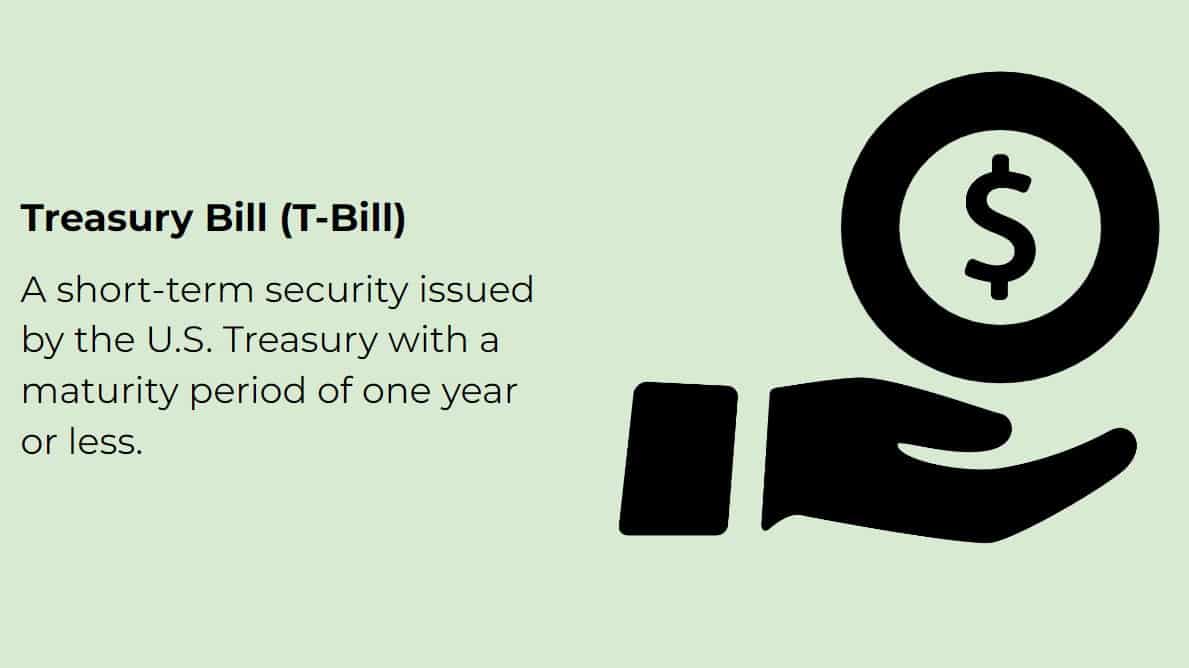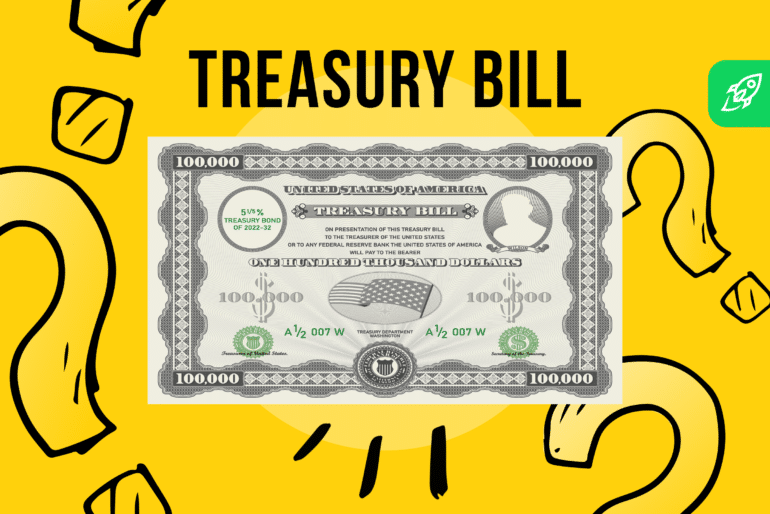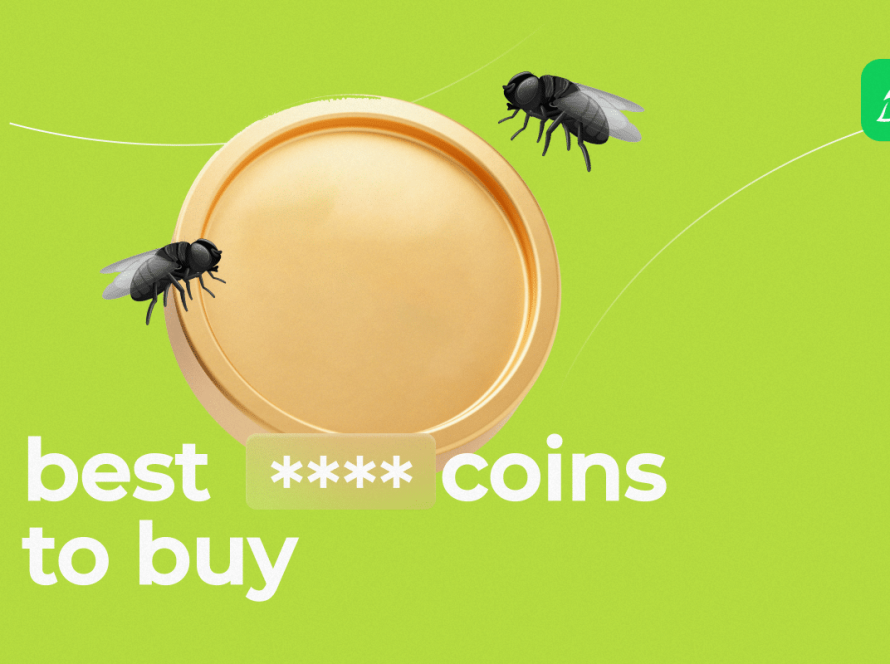[ad_1]
Treasury bills are a safe haven for investors looking to stabilize their portfolios. These short-term securities, backed by the full faith and credit of the U.S. government, offer a reliable income source with virtually no default risk. They can be an excellent choice for preserving capital and generating steady, albeit modest, returns.
This article talks about the nature of T-Bills, their mechanics, benefits and risks associated with investing in them, and their role within a diversified portfolio. As a crypto investor myself, I strongly appreciate Treasury bills and the reliability they can offer to offset the risks coming from the other, mostly crypto, assets in my portfolio. If you are also a part of the crypto sphere or if you’re a traditional investor contemplating how to diversify and stabilize your portfolio, it is important to understand the value Treasury bills can provide.
What Is a Treasury Bill?
A Treasury bill, often referred to as a T-Bill, is a short-term security issued by the U.S. Treasury. They are one of the safest investments available because they are backed by the full faith and credit of the federal government. Treasury bills are part of the broader category of treasury securities, which also include Treasury notes and bonds. These financial instruments are key components of many investment portfolios, playing an important role in shaping one’s investment strategy.

How Do Treasury Bills Work?
Unlike traditional fixed-income investments that pay interest periodically, T-Bills are sold at a discount to their face value, which is known as the purchase price. For instance, an investor might buy a $1,000 T-Bill for $950. The federal government promises to pay the face value of the T-Bill (in this case, $1,000) upon its maturity date. The difference between the purchase price and the amount received at maturity is the interest earned by the investor.
T-Bills have various maturity periods, ranging from a few days to 52 weeks. They are considered short-term securities because their maturity periods are less than one year. The U.S. Treasury releases new T-Bills into the market through an auction process, but they can also be bought and sold in the secondary market.
What Can Affect Treasury Bill Rates?
Treasury bill rates are impacted by a number of factors, with one of the primary influences being the monetary policy of the U.S. Federal Reserve. When the Federal Reserve alters the federal funds rate — the interest rate at which banks lend to each other overnight — it indirectly impacts Treasury bill rates. For instance, when the Federal Reserve increases the federal funds rate, banks typically pass on these increased costs to consumers, leading to a rise in T-Bill rates. Similarly, a decrease in the federal funds rate often results in lower Treasury bill rates.
Another significant factor affecting T-Bill rates is the overall state of the economy, reflected in macroeconomic conditions such as inflation and unemployment rates. During periods of economic uncertainty or instability, investors often flock to the relative safety of Treasury bills, leading to an increase in demand and a consequent decrease in yield (or rate).
Conversely, in strong economic conditions, investors might shift towards riskier assets with potentially higher returns, which could result in decreased demand for T-Bills and, in turn, could increase their yield. Therefore, the fluctuating dynamics of supply and demand in response to changes in the economic landscape play a pivotal role in determining Treasury bill rates.
How to Buy T-Bills
Investors can buy T-Bills directly from the U.S. Treasury through the TreasuryDirect website. The minimum purchase is $100, and they can be bought in increments of $100. Investors can also purchase T-Bills in the secondary market through banks or brokers. It’s essential to understand the current macroeconomic conditions, particularly the discount rate, before buying T-Bills.
Benefits of Investing in Treasury Bills
One of the main benefits of investing in T-Bills is their safety. Since they are guaranteed by the U.S. government, they are considered a virtually risk-free investment. So, they can provide a steady income stream for investors, especially during uncertain economic times when other investments may be risky.
T-Bills also provide tax advantages. The income earned from T-Bills is exempt from local income taxes and is only subjected to federal taxes. This can be an advantage over other investments like certificates of deposit or high-yield savings accounts, where the interest earned may be subject to both federal and state income taxes.
The Risks of Investing in Treasury Bills
Despite their safety, T-Bills are not entirely without risk. One primary risk is inflation. If the inflation rate is higher than the yield of the T-Bill, the purchasing power of the returns may be eroded. This is known as inflation risk.
Reinvestment risk poses another danger. When T-Bills mature, the investor may have to reinvest the funds in a new T-Bill with a potentially lower yield, depending on the prevailing interest rates. The investor may not earn as much interest income as previously, altering their overall investment strategy.
Treasury Bills vs. Treasury Bonds vs. Treasury Notes
T-Bills, Treasury bonds, and Treasury notes are all types of U.S. Treasury securities, but they differ in their maturity periods and the way they pay interest. As we’ve discussed, T-Bills are short-term investments that do not pay interest but are sold at a discount and mature at face value.
On the other hand, Treasury notes have maturity periods of two to ten years and pay interest every six months. Treasury bonds have the longest maturity periods of all Treasury securities, ranging from 10 to 30 years, and like notes, they also pay interest semiannually.
Treasury Bills and Crypto
Investors often include both treasury bills and cryptocurrencies like Bitcoin or Dogecoin in their investment portfolios to achieve a balanced investment strategy. While T-Bills are safe and provide stable returns, cryptocurrencies can offer higher potential returns. Yet, they come with much higher risk. The key is to have a diversified portfolio to spread the risk.
Some stablecoins are backed by reserves of safe assets, which sometimes include Treasury bills. This adds a layer of security and stability to these digital assets, as they are pegged to the value of these low-risk investments.
FAQ
Are Treasury bills a good investment?
It depends on your overall investing strategy. Since there are comparatively not as many factors that can affect T-bill prices, Treasury bills are a great way to offset risk.
Treasury bills are a safe investment choice, but as with all investment decisions, it’s essential to consider your financial goals, risk tolerance, and investment timeline.
What is the rate on a 6-month treasury bill?
The rate on a 6-month Treasury bill represents the return an investor can expect if they hold the T-Bill for six months until its maturity. This rate varies over time due to changes in the overall economic environment and the bond market. The U.S. Treasury Department conducts regular auctions to determine the discount rate or the rate at which the T-Bills are issued. You can find current and historical rates for T-Bills on the U.S. Treasury’s website or financial news and information websites.
What is a Zero Coupon Treasury Bill?
A Zero Coupon Treasury bill is a type of government security that does not pay interest payments. Instead, it is issued at a discount to its face value, and the investor receives the full face value at maturity. For example, you may buy a $1,000 zero-coupon T-Bill at a $950 purchase price. When the T-Bill matures, the U.S. Treasury will pay you $1,000. The $50 difference is the income earned on the investment.
What is a US Treasury Bill?
A U.S. Treasury Bill is a short-term debt obligation backed by the U.S. government with a maturity period of less than one year. They are issued through a competitive bidding process at a discount to par, which means they pay no interest payments, and the return is the difference between the purchase price and the amount received at maturity. As one of the safest investments, T-Bills are used by conservative investors to preserve capital over a short period of time.
What is the yield on a 6-month Treasury Bill?
The yield on a 6-month Treasury bill is essentially the return an investor can expect if they buy the T-Bill and hold it until it matures in six months. It’s calculated based on the purchase price and the face value of the T-Bill. As with the rate, the yield can fluctuate based on economic conditions, interest rate risk, and changes in the bond market.
What is a Treasury Bill Vs Bond?
While both Treasury bills and bonds are types of government securities, they differ significantly in terms of maturity periods and interest payouts. A Treasury bill is a short-term investment that doesn’t pay regular interest. Instead, it’s sold at a discount and pays the face value upon maturity. On the other hand, Treasury bonds are long-term investments with maturities of up to 30 years. They pay regular interest payments every six months and return the face value of the bond at maturity.
What is a 3-month Treasury Bill?
A 3-month Treasury bill is a short-term government security with a maturity period of three months. Like other T-Bills, it is sold at a discount to face value and does not make regular interest payments. The return to the investor is the difference between the purchase price and the face value paid at the end of the three-month period. These T-Bills are popular among investors looking for a safe, short-term investment.
Disclaimer: Please note that the contents of this article are not financial or investing advice. The information provided in this article is the author’s opinion only and should not be considered as offering trading or investing recommendations. We do not make any warranties about the completeness, reliability and accuracy of this information. The cryptocurrency market suffers from high volatility and occasional arbitrary movements. Any investor, trader, or regular crypto users should research multiple viewpoints and be familiar with all local regulations before committing to an investment.
[ad_2]
Source link




